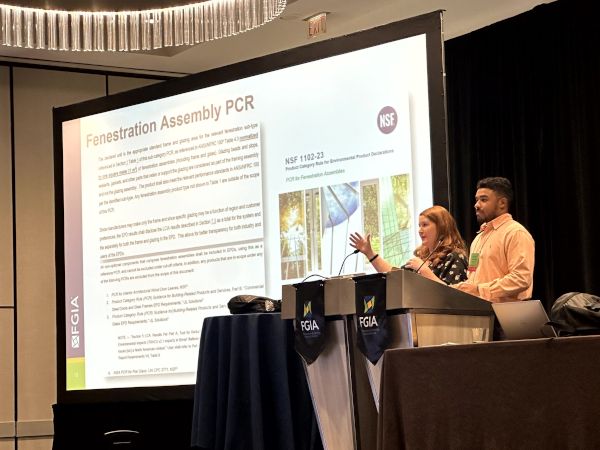
Date: 26 September 2024
Sustainability was an important theme throughout the Fenestration and Glazing Industry Alliance (FGIA) 2024 Fall Conference, with sessions covering vinyl life cycle assessments (LCAs), the future of environmental product declarations (EPDs) and embodied carbon legislation on the federal and state levels. Expert speakers answered participant questions and shared the latest knowledge on these topics.
An Industry-Wide LCA Study
Presenters Nicole Meyer and Marquis Miller (Sustainability Solutions Corporation) led a discussion entitled "How to Use Vinyl Industry LCAs?” which provided an overview of LCAs and shared lessons learned, as well as findings from SSC’s recent industry-wide LCA study made possible by FGIA members. “LCAs are not one size fits all,” said Meyer. “You need to understand the baseline.”
FGIA member companies commissioned SSC to conduct an industry-wide LCA study. Each manufacturer participated in data collection efforts in 2023 and 2024, using data from 2022. SSC developed an average LCA model, an ISO-compliant LCA report and an industry-wide LCA fact sheet. “We covered six manufacturers and 14 manufacturing sites, and the functional unit was 1 kg of PVC fenestration lineal product,” said Meyer, adding that there is not currently a Product Category Rule (PCR) specific to PVC lineals, as they are part of a system rather than a final product used in a building application.
Miller shared lessons learned from the research. “Participating member companies' extruded vinyl products compared favorably against other industry average vinyl product global warming potential (GWP) results,” he said. “Raw materials were the primary driver of environmental impacts, attributing to 84.8 percent of the total GWP impact.” Miller encouraged participants to use the LCA to leverage the data for other sustainability initiatives. “Understand the environmental impacts and hotspots across the life cycle of your product,” he said. “Create a better product with verified results and use your LCA as a tool to drive innovation.”
The Present State and Future of EPDs
A session called "EPDs | Where Do We Go from Here?" was led by Richard Braunstein (Oldcastle BuildingEnvelope). Braunstein gave an overview of EPDs, how they are used today and where the industry will go from here. “Sustainability means meeting the needs of today without compromising the needs of future generations,” said Braunstein. “But it is also unambiguous, a condition without compromise. We have a responsibility to do our part in the effort to mitigate climate change.”
In terms of how EPDs are being put into practice today, Braunstein said we should celebrate their value. When it comes to marketing, “EPDs are great tools to substantiate your claims about your products,” he said. “Have that knowledge in your back pocket when going to the marketplace.”
As for their future, Braunstein suggested being prepared. “If you don't see your product material on [the Federal Buy Clean Initiative] list, it doesn't mean it won't be on there tomorrow,” he said. “It is only a matter of time.” Braunstein recommended looking to state, city and local jurisdictions to get a glimpse into the future. “The private sector is getting much more involved with requiring EPDs, simply because the market demands it thanks to millennials, who are more focused on the effects of climate change,” he said.
Participants can expect EPDs to become less expensive. “How do we reduce the $50,000-$60,000 price tag of an EPD in the future?” Braunstein asked. “The Environmental Protection Agency (EPA) is using Inflation Reduction Act (IRA) funding to develop cost-effective EPDs.” Braunstein also expects them to become digital in the future, and more cost-effective to produce and revise.
Following Federal, State Embodied Carbon Legislation
A final session on sustainability labelled "Understanding How Federal and State Embodied Carbon Legislation Can Impact Your Business” was led again by presenters Meyer and Miller from Sustainability Solutions Corporation. “Embodied carbon consists of all the greenhouse gas (GHG) emissions associated with the extraction, processing, transport, manufacturing, installation, use and disposal of building materials,” said Miller.
The pair shared the latest information about federal policies and legislation, including the 2022 IRA, which provides billions of dollars in grant and loan programs and other investments for clean energy and climate action. “The IRA provides $250 million to support the development and standardization of EPDs,” said Meyer, echoing Braunstein’s suggestion that EPDs can become less expensive through the EPA. Additionally, there is an EPA label program for low embodied carbon construction materials.
“The EPA wants better EPD data quality, but the timeline is not really set,” said Meyer. Starting in May 2023, the General Services Administration (GSA) piloted interim requirements for the use of low embodied carbon construction materials in GSA projects funded by the IRA.
States like New Jersey and California are doing their own work in this space, said Miller, and Colorado is committed to 100 percent net-zero greenhouse gas emissions by 2050. Even if companies are not operating in these states, the time to begin collecting internal data is now, Meyer explained. “Good data is good data,” she said. “Start tracking now before things accelerate so you don't get left behind.”
For more information about FGIA and its activities, visit FGIAonline.org.
 600450
600450







Add new comment